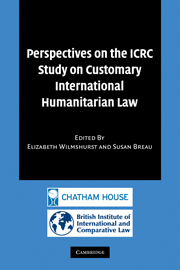Book contents
- Frontmatter
- Contents
- Preface
- List of contributors
- Table of cases
- Table of treaties and other instruments
- Abbreviations
- Part 1 Setting the scene: Theoretical perspectives on international law in the ICRC Study
- Part 2 The status of conflict and combatants: The ICRC Study
- Part 3 Commentary on selected Rules from the ICRC Study
- 6 The law of targeting
- 7 Protected persons and objects
- 8 Natural environment
- 9 Specific methods of warfare
- 10 Weapons, means and methods of warfare
- 11 Fundamental guarantees
- 12 Status and treatment of prisoners of war and other persons deprived of their liberty
- 13 Displacement and displaced persons
- 14 Implementation and compliance
- 15 War crimes
- Part 4 Conclusions
- Index
7 - Protected persons and objects
Published online by Cambridge University Press: 09 July 2009
- Frontmatter
- Contents
- Preface
- List of contributors
- Table of cases
- Table of treaties and other instruments
- Abbreviations
- Part 1 Setting the scene: Theoretical perspectives on international law in the ICRC Study
- Part 2 The status of conflict and combatants: The ICRC Study
- Part 3 Commentary on selected Rules from the ICRC Study
- 6 The law of targeting
- 7 Protected persons and objects
- 8 Natural environment
- 9 Specific methods of warfare
- 10 Weapons, means and methods of warfare
- 11 Fundamental guarantees
- 12 Status and treatment of prisoners of war and other persons deprived of their liberty
- 13 Displacement and displaced persons
- 14 Implementation and compliance
- 15 War crimes
- Part 4 Conclusions
- Index
Summary
Introduction
The principle of distinction between civilians and combatants is one of the most fundamental in international humanitarian law. The Rules proposed for the elaboration of this principle are discussed in chapter 6 above. But over and above the protections afforded to all civilians and civilian objects, the law singles out certain categories of civilians for special protection. Special protection includes two elements – respect and protection. It provides not only for the negative prohibition of sparing an object or person from attack but includes a positive obligation on belligerents to adhere to special measures of respect. Rules 25–42 of the Study propose statements of customary law with regard to certain categories deserving of special protection. This chapter discusses those Rules and the treaty law which lies behind them. Additionally this chapter discusses the broader focus of protection of women, children, and the elderly, disabled and infirm which extends from combat to occupation and which is addressed in Rules 134–138.
The listing of specifically protected persons and objects dates from the earliest humanitarian law instrument. Although the Study deals with rules of customary international law, there has been extensive and long-standing development of treaty rules in this area which either reflect existing custom or lead to a codification of custom.
- Type
- Chapter
- Information
- Publisher: Cambridge University PressPrint publication year: 2007
- 4
- Cited by



